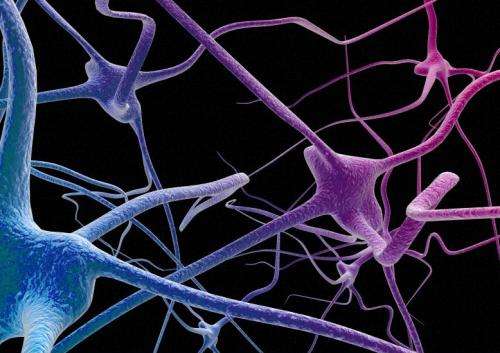Neurons that can multitask greatly enhance the brain's computational power, study finds

Over the past few decades, neuroscientists have made much progress in mapping the brain by deciphering the functions of individual neurons that perform very specific tasks, such as recognizing the location or color of an object.
However, there are many neurons, especially in brain regions that perform sophisticated functions such as thinking and planning, that don't fit into this pattern. Instead of responding exclusively to one stimulus or task, these neurons react in different ways to a wide variety of things. MIT neuroscientist Earl Miller first noticed these unusual activity patterns about 20 years ago, while recording the electrical activity of neurons in animals that were trained to perform complex tasks.
"We started noticing early on that there are a whole bunch of neurons in the prefrontal cortex that can't be classified in the traditional way of one message per neuron," recalls Miller, the Picower Professor of Neuroscience at MIT and a member of MIT's Picower Institute for Learning and Memory.
In a paper appearing in Nature on May 19, Miller and colleagues at Columbia University report that these neurons are essential for complex cognitive tasks, such as learning new behavior. The Columbia team, led by the study's senior author, Stefano Fusi, developed a computer model showing that without these neurons, the brain can learn only a handful of behavioral tasks.
"You need a significant proportion of these neurons," says Fusi, an associate professor of neuroscience at Columbia. "That gives the brain a huge computational advantage."
Lead author of the paper is Mattia Rigotti, a former grad student in Fusi's lab.
Multitasking neurons
Miller and other neuroscientists who first identified this neuronal activity observed that while the patterns were difficult to predict, they were not random. "In the same context, the neurons always behave the same way. It's just that they may convey one message in one task, and a totally different message in another task," Miller says.
For example, a neuron might distinguish between colors during one task, but issue a motor command under different conditions.
Miller and colleagues proposed that this type of neuronal flexibility is key to cognitive flexibility, including the brain's ability to learn so many new things on the fly. "You have a bunch of neurons that can be recruited for a whole bunch of different things, and what they do just changes depending on the task demands," he says.
At first, that theory encountered resistance "because it runs against the traditional idea that you can figure out the clockwork of the brain by figuring out the one thing each neuron does," Miller says.
For the new Nature study, Fusi and colleagues at Columbia created a computer model to determine more precisely what role these flexible neurons play in cognition, using experimental data gathered by Miller and his former grad student, Melissa Warden. That data came from one of the most complex tasks that Miller has ever trained a monkey to perform: The animals looked at a sequence of two pictures and had to remember the pictures and the order in which they appeared.
During this task, the flexible neurons, known as "mixed selectivity neurons," exhibited a great deal of nonlinear activity—meaning that their responses to a combination of factors cannot be predicted based on their response to each individual factor (such as one image).
Expanding capacity
Fusi's computer model revealed that these mixed selectivity neurons are critical to building a brain that can perform many complex tasks. When the computer model includes only neurons that perform one function, the brain can only learn very simple tasks. However, when the flexible neurons are added to the model, "everything becomes so much easier and you can create a neural system that can perform very complex tasks," Fusi says.
The flexible neurons also greatly expand the brain's capacity to perform tasks. In the computer model, neural networks without mixed selectivity neurons could learn about 100 tasks before running out of capacity. That capacity greatly expanded to tens of millions of tasks as mixed selectivity neurons were added to the model. When mixed selectivity neurons reached about 30 percent of the total, the network's capacity became "virtually unlimited," Miller says—just like a human brain.
Mixed selectivity neurons are especially dominant in the prefrontal cortex, where most thought, learning and planning takes place. This study demonstrates how these mixed selectivity neurons greatly increase the number of tasks that this kind of neural network can perform, says John Duncan, a professor of neuroscience at Cambridge University.
"Especially for higher-order regions, the data that have often been taken as a complicating nuisance may be critical in allowing the system actually to work," says Duncan, who was not part of the research team.
Miller is now trying to figure out how the brain sorts through all of this activity to create coherent messages. There is some evidence suggesting that these neurons communicate with the correct targets by synchronizing their activity with oscillations of a particular brainwave frequency.
"The idea is that neurons can send different messages to different targets by virtue of which other neurons they are synchronized with," Miller says. "It provides a way of essentially opening up these special channels of communications so the preferred message gets to the preferred neurons and doesn't go to neurons that don't need to hear it."
This story is republished courtesy of MIT News (web.mit.edu/newsoffice/), a popular site that covers news about MIT research, innovation and teaching.



















